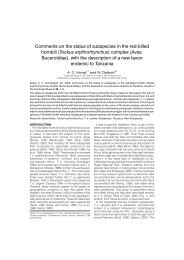EAZA Hornbill Management and Husbandry Guidelines
EAZA Hornbill Management and Husbandry Guidelines
EAZA Hornbill Management and Husbandry Guidelines
Create successful ePaper yourself
Turn your PDF publications into a flip-book with our unique Google optimized e-Paper software.
4.8 Furnishing of the enclosure<br />
4.8.1 Water source<br />
<strong>Hornbill</strong>s do not usually need a water pool for drinking but will drink water if the diet<br />
supplies insufficient water. Occasionally hornbills use shallow water pools for bathing.<br />
Pools, small streams <strong>and</strong> waterfalls can add aesthetic value to enclosures <strong>and</strong> may also be<br />
necessary because of public perception. They can also serve as vehicles for<br />
environmental enrichment. See also Section 3.4: Environmental enrichment <strong>and</strong> training.<br />
4.8.2 Vegetation<br />
Vegetation adds aesthetic value to enclosures, provides perching <strong>and</strong> can create sound<br />
<strong>and</strong> visual barriers (see also Section 4.1: Disturbance). Vegetation can allow hornbills to<br />
get out of each other’s direct view, which may help reduce aggression. It has been noted<br />
at Rotterdam Zoo that both male Buceros <strong>and</strong> Aceros hornbills l<strong>and</strong> on a flexible branch<br />
of a living tree, grasping the branch with their feet <strong>and</strong> shaking it. This activity may have<br />
a display function or may otherwise serve as an outlet for aggression. Rhinoceros<br />
hornbills Buceros rhinoceros at Paignton Zoo enjoy bathing in rainwater that collects on<br />
the leaves at the flat tops of shrubs in their aviary. For that reason the small leafed fly<br />
honeysuckle Lonicera nitida was planted (J. Gregson, pers. comm.). Vegetation is also<br />
important in humidity control (see also Section 4.4: Sprinkling <strong>and</strong> humidity).<br />
The enclosure should contain plants of various heights, <strong>and</strong> outdoor enclosures should<br />
have a few taller living trees that serve as shelters. Suggested plants are: Gramineae (e.g.<br />
Arundinaria), Bougainvilleae, Ficus, Polygonum, Yucca, Hibiscus, Hedera <strong>and</strong> nonpoisonous<br />
climbing plants, e.g. Lonicera nitida. If the vegetation is all planted at the<br />
same time (or the hornbills are introduced to a fully-planted enclosure) the hornbills<br />
should theoretically focus less on destroying any particular plant.<br />
4.8.3 Perches<br />
Perches should optimize hornbill use of vertical <strong>and</strong> horizontal enclosure space. Care<br />
should be taken to position perches so that the birds' flight path is not obstructed. Placing<br />
perches at different heights provides more perching options, <strong>and</strong> hornbills often jump<br />
back <strong>and</strong> forth between different levels. A stable perch should be placed where the male<br />
can extend his wings <strong>and</strong> has sufficient room above his head to mount the female during<br />
copulation. Perches should be fundamentally horizontal in inclination, <strong>and</strong> variable in<br />
size so that the feet <strong>and</strong> toes are well exercised. Perches that are too small in diameter can<br />
result in the foot being punctured by a toenail however. Some of the natural perches<br />
should have small, forked side-branches that hornbills can use to clean the inside of their<br />
bills.<br />
32




